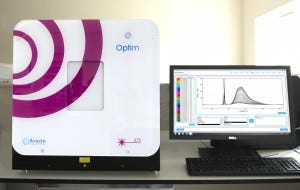Content Spotlight
Podcast: MilliporeSigma says education vital to creating unbreakable chain for sustainability
MilliporeSigma discusses the importance of people, education, and the benefits of embracing discomfort to bolster sustainability efforts.
February 11, 2015
 Avacta Analytical has extended the versatility of the Optim® 2 protein stability and characterisation instruments, with a version featuring an additional 375-nm laser that significantly enhances the measurement of stability information for membrane proteins. “Approximately 30% of the human genome encodes membrane proteins, which include receptors, transport proteins and enzymes,” says Avacta’s Dr. Geoff Platt. “So, this product will be of particular interest to those responsible for formulation and research in drug companies and academia.”
Avacta Analytical has extended the versatility of the Optim® 2 protein stability and characterisation instruments, with a version featuring an additional 375-nm laser that significantly enhances the measurement of stability information for membrane proteins. “Approximately 30% of the human genome encodes membrane proteins, which include receptors, transport proteins and enzymes,” says Avacta’s Dr. Geoff Platt. “So, this product will be of particular interest to those responsible for formulation and research in drug companies and academia.”
The capability of the Optim 375 was recently evaluated in the Faculty of Biological Sciences at the University of Leeds. This work showed that whilst the use of intrinsic fluorescence to study the unfolding of membrane proteins is particularly effective for samples containing significant extra-membranous domains, for some proteins tryptophan is not a useful probe. However, the employment of a highly reactive thiol-specific fluorescent dye (CPM) with the Optim 375 allowed clear observation of unfolding for proteins containing buried cysteine residues, even at low concentrations (< 0.5 mg/ml) of the protein, making it a highly sensitive method. These measurements were shown to work well for many membrane proteins that are otherwise difficult to characterise; particularly integral membrane proteins such as transporters, ion channels and G protein-coupled receptors.
The Optim 375 can be used to effectively guide purification and biophysical characterisation efforts, including crystallisation, by tracking the exposure of cysteine residues within the protein interior as an indicator of protein unfolding, with the ability to simultaneously follow protein aggregation using the system’s built-in static light scattering.
Following the evaluation of the Optim 375, Dr. Platt said: “I am grateful to the staff of the University of Leeds, who also helped us develop an application note for this instrument. Their work demonstrated the advantages of the extra laser by studying both the conformational thermal stability of the proteins and their propensity to aggregate. This also highlighted the other main benefits of Optim technology; ultra-low sample volumes, high-speed analysis and with the ‘Optim Client’ software, we were able to quickly and easily apply a range of different settings for each sample.”
Developed to reduce the time and cost of therapeutic protein pre-formulation studies, the Optim family of analysers are utilised in applications such as lead candidate selection and optimisation, candidate formulation and stability studies. The speed and cost advantages that these instruments deliver are due to the tiny sample volumes required (9 microlitres), and the ability to undertake parallel measurements of up to 48 samples in just a few hours.
You May Also Like